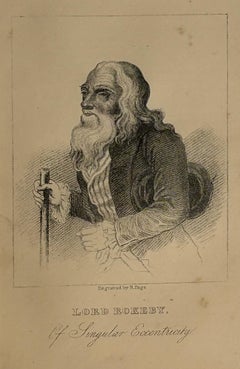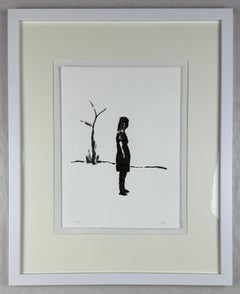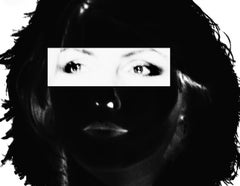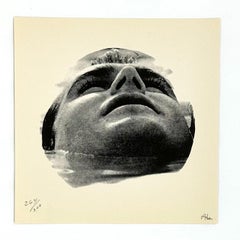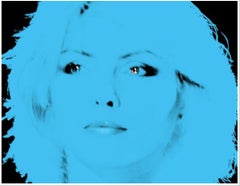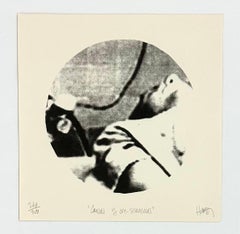Photography Figurative Prints
to
198
587
291
221
109
48
Overall Width
to
Overall Height
to
369
270
57
55
54
37
25
19
18
11
11
6
4
37
27
21
18
16
57
292
660
250
23
21
46
25
14
19
57
133
67
62
37
919
268
63
26,757
14,654
10,602
8,999
7,748
6,954
4,619
4,176
2,399
2,011
1,937
1,834
1,659
1,458
1,445
1,433
1,430
1,259
1,206
1,112
393
369
245
107
96
313
547
550
500
Art Subject: Photography
Lord Rokeby - Of Singular Eccentricity
Located in Bournemouth, Dorset
Matthew Robinson-Morris, second Baron Rokeby, an eccentric. Stipple engraving by R. Page
"His political independence was matched by his singular appearance and eccentric habits. He ...
Category
19th Century Figurative Prints
Materials
Engraving
$104 Sale Price
20% Off
Xisco Mensua Spanish artist 1995 original signed framed engraving print n1
By Xisco Mensua
Located in Miami, FL
Xisco Mensua (Spain, 1960)
Untitled from Portfolio "Junio - Julio", 1995
engraving on paper
12.6 x 9.5 in. (32 x 24 cm.)
Edition of 6
Frame 16x20 in.
ID: MEN1253-001
Hand-signed by a...
Category
1990s Contemporary Landscape Prints
Materials
Paper, Engraving
Neg Edit Blondie - Signed Limited Edition
By BATIK
Located in London, GB
Neg Edit Blondie by BATIK
Archival pigment pop art print of pop culture icon Debbie Harry of punk rock glam band Blondie –
signed & limited edition.
Grande XL 40×30″ inches / 101 ...
Category
2010s Modern Figurative Prints
Materials
Archival Pigment
Alain Pino "Untitled" from La Huella Múltiple, 2002, 8.1x8.1 in
By Alain Pino
Located in Miami, FL
Alain Pino (Cuba, 1974)
'Untitled (La Huella Múltiple)', 2002
engraving on paper
8.1 x 8.1 in. (20.5 x 20.5 cm.)
Edition of 300
ID: HUE-244
Hand-signed by author
Category
Early 2000s Contemporary Prints and Multiples
Materials
Paper, Engraving
Blondie Blue - Signed Limited Edition
By BATIK
Located in London, GB
Blondie Blue by BATIK
Archival pigment pop art print of pop culture icon Debbie Harry of punk rock glam band Blondie –
Giant 60×40″ inches / 152 x 101 cm
signed and numbered by ar...
Category
2010s Modern Figurative Prints
Materials
Archival Pigment
Hanoi Perez Cuban Artist Original Hand Signed engraving, photoengraving 2002
Located in Miami, FL
Hanoi Pérez (Cuba, 1976)
'Causas y con consecuencias (La Huella Múltiple)', 2002
engraving, photoengraving on paper
8.1 x 8.1 in. (20.5 x 20.5 cm.)
Edition of 300
ID: HUE-243
Hand-si...
Category
Early 2000s Contemporary Prints and Multiples
Materials
Paper, Screen
Franklin Alvarez Cuban Artist Original Hand Signed engraving 2002
By Franklin Alvarez Fortun
Located in Miami, FL
Franklin Alvarez (Cuba, 1971)
'Untitled (La Huella Múltiple)', 2002
engraving on paper
8.1 x 8.1 in. (20.5 x 20.5 cm.)
Edition of 300
ID: HUE-204
Hand-signed by author
Category
Early 2000s Contemporary Prints and Multiples
Materials
Paper, Screen
Pavel Acosta Cuban Artist Original Hand Signed engraving 2002
Located in Miami, FL
Pavel Acosta (Cuba, 1980)
'1,2,3 m2 (La Huella Múltiple)', 2002
engraving on paper
8.1 x 8.1 in. (20.5 x 20.5 cm.)
Edition of 300
ID: HUE-202
Hand-signed ...
Category
Early 2000s Contemporary Prints and Multiples
Materials
Paper, Screen
Tomorrow
Located in Ibadan, Oyo
No matter what happens, or how bad it seems today, life does go on, and it will be better tomorrow. We have always held to the hope, the belief, the conviction that there is a better...
Category
21st Century and Contemporary Contemporary Figurative Prints
Materials
Canvas, Linen, Ink, Linocut
Federico en New York #3 2005 Original Signed Limited Edition Screenprint Spanish
Located in Miami, FL
Eduardo Naranjo (Spain, 1944)
'Calles y sueños (Federico en Nueva York)', 2005
silkscreen on paper
Image size: 23.8 x 19.9 in. (60.50 x 50.50 cm.)
Surface size: 30.8 x 24.9 in. (78 x...
Category
Early 2000s Surrealist Prints and Multiples
Materials
Screen
Lithograph Lady Rider Woman on a Horse Marie Laurencin French Post Impressionist
Located in Surfside, FL
Marie Laurencin (French, 1883-1956)
Lithograph of a colored pencil drawing depicting a woman wearing a hat and riding horseback side saddle,
Edition "37/115" to lower left and hand signed "Laurencin" in pencil to lower right, with a cloth mat and housed in a silvered wood frame.
Dimensions: Image, 12" H x 16" W; frame, 19.75" H x 23.5" W x 1.5" D.
Marie Laurencin (1883 – 1956) was a French painter and printmaker. She became an important figure in the Parisian avant-garde as a member of the Cubists associated with the Section d'Or.
Laurencin was born in Paris, where she was raised by her mother and lived much of her life. At 18, she studied porcelain painting in Sèvres. She then returned to Paris and continued her art education at the Académie Humbert, where she changed her focus to oil painting.
During the early years of the 20th century, Laurencin was an important figure in the Parisian avant-garde. A member of both the circle of Pablo Picasso, and Cubists associated with the Section d'Or, such as Jean Metzinger, Albert Gleizes, Robert Delaunay, Henri le Fauconnier and Francis Picabia, exhibiting with them at the Salon des Indépendants (1910-1911) and the Salon d'Automne (1911-1912), and Galeries Dalmau (1912) at the first Cubist exhibition in Spain. She became romantically involved with the poet Guillaume Apollinaire, and has often been identified as his muse. In addition, Laurencin had important connections to the salon of the American expatriate and lesbian writer Natalie Clifford Barney. She had relationships with men and women, and her art reflected her life, her "balletic wraiths" and "sidesaddle Amazons" providing the art world with her brand of "queer femme with a Gallic twist."
Laurencin's oeuvre include painting, watercolor paintings, drawing, and prints. She is known as one of the few female Cubist painters, with Sonia Delaunay, Marie Vorobieff, and Franciska Clausen...
Category
Mid-20th Century Post-Impressionist Animal Prints
Materials
Lithograph
Interference, Football Color Etching by LeRoy Neiman 1972
By LeRoy Neiman
Located in Long Island City, NY
Artist: LeRoy Neiman, American (1921 - 2012)
Title: Interference
Year: 1972
Medium: Etching, signed and numbered in pencil
Edition: 54/150
Image Size: 7.5 x 8.4 inches
Size: 9 x 9.25...
Category
1970s American Impressionist Figurative Prints
Materials
Etching
Jack and Jill -- Print, Nursery Rhymes, Etching, Aquatint by Paula Rego
By Paula Rego
Located in London, GB
Jack and Jill, 1989
Paula Rego
Etching with aquatint, on Velin Arches wove
Signed and inscribed ‘A/P’
One of fourteen artist’s proofs aside from the number...
Category
1980s Contemporary Figurative Prints
Materials
Aquatint, Etching
Yovani Bauta, ¨Untitled¨, 2011, Engraving, 16.1x13 in
Located in Miami, FL
Yovani Bauta (Cuba, 1957)
'Untitled 1 (retrato)', 2003
engraving on paper Guarro Biblos 250g.
16.2 x 13 in. (41 x 33 cm.)
Edition of 15
ID: BAU-315
Unframed
Category
2010s Contemporary Prints and Multiples
Materials
Paper, Engraving, Etching, Aquatint
"Black Tulip II #3/20" (2017) By Kate Breakey, Limited Edition Print
By Kate Breakey
Located in Denver, CO
"Black Tulip II #3/20" (2017) by Kate Breakey is a limited edition print on museum glass and gilded with 24K gold leaf.
About the artist:
Kate Breakey is internationally known for ...
Category
2010s Landscape Prints
Materials
Gold Leaf
M.J. Luquet - Etching by Charles Jaque - 1870s
Located in Roma, IT
M.J. Luquet is an artwork realized by Charles Jaque in the 1870s.
Etching.
Good conditions.
Realized for the "Société des Aquafortistes. Born on the initiative of the publisher Al...
Category
1870s Modern Figurative Prints
Materials
Etching
Black and White Etching of Angels
Located in Houston, TX
Monochromatic abstract figurative lithograph of the Seven Archangels. Framed and matted in a beautiful ornate gold frame. Unsigned.
Dimensions With Frame: H 6.13 in. x W 8 in.
Category
Early 20th Century Abstract Figurative Prints
Materials
Lithograph
Little London: St Paul’s (aqua blue), London Cityscape Art, Famous Architecture
Located in Deddington, GB
Michael Wallner, Little London: St Paul’s (aqua blue), framed brushed aluminium print, 25 x 18 x 3 cm approx, limited edition of 30.
I love the beautiful lines, shapes and intricate patterns in the dome of London’s most famous cathedral. This piece of art is created from my original photograph, digitally manipulated to trace the dome’s outlines and coloured by hand on a graphics tablet.
The image is then printed directly on a small piece of brushed aluminium, which gives the piece an etched appearance. The design of the dome itself appear as aluminium lines. The metal print is floated in hand-painted waxed wood frame.
The piece is from my Little London collection: “Celebrate the Big Smoke...
Category
2010s Contemporary Figurative Prints
Materials
Metal
Le Petit Branconnier - Etching by Jacques-Joseph Lecurieux - 1870s
Located in Roma, IT
Le Petit Branconnier is an artwork realized by Jacques-Joseph Lecurieux in the 1870s.
Etching.
Good conditions.
Realized for the "Société des Aquafortistes. Born on the initiativ...
Category
1870s Modern Figurative Prints
Materials
Etching
Bracelets, 1990
Located in Greenwich, CT
Bracelets is an expertly crafted, embossed serigraph on paper with foil stamping and an image size of 20.25 x 9.5 inches. From the edition of 650, the art is numbered 96/300 and esta...
Category
20th Century Art Deco Prints and Multiples
Materials
Paper, Screen
Truman Capote and Snake, Pop Art Screenprint by Mike McKensie
Located in Long Island City, NY
Artist: Mike McKenzie, American (1954 - )
Title: Truman Capote and Snake
Year: circa 1992
Medium: Screenprint, signed and numbered in pencil
Edition: 10/20
Size: 15 x 12 in. (38.1 x ...
Category
1990s Pop Art Figurative Prints
Materials
Screen
"Angel More" from Mother of Us All by Robert Indiana
Located in Hinsdale, IL
ROBERT INDIANA
Angel More
(Mother of Us All)
Screenprint in colors on Arches, 1977
Impression 14 of an edition of 150
Image Size: 18” x 14”
Signed, dated, and numbered in lower margin
Printed by Mourlot, Paris.
Intended for publication by Amiel, New York.
Sheehan 96-108.
The Mother of Us All, is an opera which imaginatively chronicles the story of Susan B. Anthony and the women's suffrage movement, written by Gertrude Stein and composed by Virgil Thompson in 1945. In 1976 Robert Indiana was hired to create the costumes and set design for the Santa Fe Opera Company’s production of The Mother to Us All. This collection of lithographs illustrates Indiana's costume designs for the Virgil Thomson-Gertrude Stein same-titled opera.
Robert Indiana is one of the most recognized names in Contemporary and Pop Art, his LOVE sculptures, paintings, and prints are by far his most iconic pieces. It all began in the summer of 1965, when The Museum of Modern Art commissioned Indiana to design its Christmas card. He submits LOVE in four color possibilities; the museum selects the red, blue, and green version. In 1967 he produces three serigraphs of LOVE, and two serigraphs of LOVE Wall. During the next two years, produces other serigraph variations on LOVE, with more following in 1972, 1973, 1975, 1982, and 1991. Indiana’s LOVE motif has since been translated into a US postage stamp...
Category
1970s Art Nouveau Figurative Prints
Materials
Screen
Untitled (Monster, Better believe it)
Located in Surfside, FL
Born in 1940 in Shostka, Ukraine, Konstantin Bokov immigrated to New York City in 1974.Born the son of Viktor Bokov, the well known poet who perished in the Soviet gulag, Konstantin Bokov was an accordion player and sheep-herderbefore he became a self-taught artist and expelled dissident.
When he appeared at the Morin-Miller Gallery in 1978 bearing a painting of a
Tropicana juice carton, Carmen Morin brought it home. Jack Miller
remembers his reaction: "We don't buy art, we sell it!" --- then their
personal collection of Bokov's work grew to over a hundred pieces.
Many paintings, sketches, collages and recycle assemblages were done,
It's been said that Bokov’s canvases and recycled pieces offer an image of
New York that is both a scathing critique and profession of love. This is
especially evident in his pieces "Manhattan Madness (Road Repair)" and his
Statue of Liberty series...
Category
20th Century Outsider Art Figurative Prints
Materials
Mixed Media
Little London: Albert Bridge
Located in Deddington, GB
Michael Wallner, Little London: Albert Bridge, framed brushed aluminium print, 18 x 25 x 3 cm approx, limited edition of 30,
Albert Bridge – my favourit...
Category
21st Century and Contemporary Contemporary Figurative Prints
Materials
Metal
"BaitHouse" Seascape Landscape Etching Signed Anderson Edition 8/10
Located in Houston, TX
Etching of a seascape with a boat house and boats. The peice is titled, signed, dated, and editioned in pencil by the artist. The etching is framed in a wooden frame with a white mat...
Category
1960s Naturalistic Landscape Prints
Materials
Etching
August Lake, Memorial Sloan Kettering Art Collection signed landscape silkscreen
Located in New York, NY
William Waitzman
August Lake (from the Memorial Sloan Kettering Art Collection), 2016
Hand printed color silkscreen on wove paper
Pencil signed and numbered 4/14 on the front
Frame i...
Category
2010s Realist Landscape Prints
Materials
Screen
The Secret
By Paul Delvaux
Located in Lake Worth Beach, FL
The Secret 1966
Lithograph on wove paper with watermark arches 20in x 25in (64cm x 50cm), paper size 29inx22in and (39inx33in) framed under glass. Pencil signed and numbered, edition 34/75. Ref. no. 4, in: Cahier Paul Delvaux, no. 1, printed by Mourlot, published by Galerie Bateau Lavoir, Paris.
Paul Delvaux, (born September 23, 1897, Antheit, Liège, Belgium—died July 20, 1994, Veurne), Belgian Surrealist painter and printmaker whose canvases typically portray transfixed nudes and skeletons in mysterious settings.
From 1920 to 1924 Delvaux studied architecture and painting at the Académie des Beaux-Arts in Brussels. His early work was influenced by Post-Impressionism and Expressionism, but after discovering the work of Salvador Dalí, Giorgio de Chirico, and his fellow Belgian René Magritte, Delvaux converted to a Surrealist style in the mid-1930s. He traveled through Italy before World War II, and the Classical architecture he encountered there developed into recurring motifs in his work. During that trip he was also greatly influenced by early 16th-century Italian Mannerist...
Category
1960s Surrealist Figurative Prints
Materials
Lithograph
Untitled -- Print, Polymer Gravure Etching, Figure, Feminist Art by Tracey Emin
By Tracey Emin
Located in London, GB
Untitled, 2004
Tracey Emin
Etching, on wove paper
Initialed from the edition of 125
Published by White Cube, London
With the artist's ink stamp on the reverse
Image: 14 × 19 cm (5.5...
Category
Early 2000s Feminist Figurative Prints
Materials
Etching
Diana after the Hunt - Etching by Charles Joshua Chaplin - 1870s
Located in Roma, IT
Diana after the Hunt is a black and white etching realized by Charles Chaplin (1825 – 1891) in 1870s.
Titled in the lower.
Image size: 19cmx24cm.
Very Good condition.
Signed in t...
Category
1870s Modern Figurative Prints
Materials
Etching
British Post Office Greetings Telegrams (1935-1978), after various artists
Located in London, GB
British Post Office Greetings Telegrams (1935-1978), after various artists
photolithograph
dimensions, including frames:
33 x Telegram 9 ¾ x 11 ⅞ in. (24.8 x 30.1 cm.)
31 x Telegram 10 ½ x 12 in. (26.8 x 30.5 cm.)
12 x Telegram 11 ½ x 18 in. (29.2 x 45.7 cm.) and similar
12 x Telegram 9 x 11 ½ in. (22.9 x 29.2 cm.)
1 x Telegram 11 ¾ x 12 ¾ in. (29.8 x 32.4 cm.)
1 x Telegram 9 x 10 ⅜ in. (22.9 x 26.3 cm.)
1 x Telegram 8 x 10 ½ in. (20.3 x 26.7 cm.)
A set of ninety-one (91)
The historical equivalent of a text or WhatsApp message, the first telegram was sent in code in 1844 from Washington to Baltimore by Samuel Morse, asking “What hath God wrought?” By 1870 (the year that the British General...
Category
20th Century Modern Figurative Prints
Materials
Lithograph
Les Sorcières - Etching by Jean Amable Pastelot - 1870s
Located in Roma, IT
Les Sorcières is a black and white etching realized by Jean Amable Pastelot in 1870s.
Titled in the lower.
Good condition.
Not signed.
Realized by Cadart for the "Société des Aqu...
Category
1870s Modern Figurative Prints
Materials
Etching
The Vans
By Ronnie Wood
Located in Toronto, ON
19" x 16.5" Framed
Limited Edition Giclée
Numbered of 140
Hand Signed by Ronnie Wood
Category
21st Century and Contemporary Figurative Prints
Materials
Giclée
$2,000
Russian Mixed Media Pop Art Collage Painting Bumble Bee, Thinking, Hard Earned
Located in Surfside, FL
Born in 1940 in Shostka, Ukraine, Konstantin Bokov immigrated to New York City in 1974.Born the son of Viktor Bokov, the well known poet who perished in the Soviet gulag, Konstantin Bokov was an accordion player and sheep-herderbefore he became a self-taught artist and expelled dissident.
When he appeared at the Morin-Miller Gallery in 1978 bearing a painting of a
Tropicana juice carton, Carmen Morin brought it home. Jack Miller
remembers his reaction: "We don't buy art, we sell it!" --- then their
personal collection of Bokov's work grew to over a hundred pieces.
Many paintings, sketches, collages and recycle assemblages were done,
It's been said that Bokov’s canvases and collage recycled pieces offer an image of
New York that is both a scathing critique and profession of love. This is
especially evident in his pieces "Manhattan Madness (Road Repair)" and his
Statue of Liberty series...
Category
20th Century Outsider Art Figurative Prints
Materials
Mixed Media
"La Princesse Lointaine", Erte, Original Serigraph numbered 291/300, Art Deco
By Erté
Located in Dallas, TX
"La Princesse Lointaine" is a serigraph created in 1984 by Erté. Classic art deco piece with a gaudy princess in yellow and pink with a star above ...
Category
1980s Art Deco Figurative Prints
Materials
Lithograph, Screen
20th century lithograph figurative print child subject doll realistic signed
Located in Milwaukee, WI
"Little Girl With Doll" is an original lithograph by James Ormsbee Chapin. The artist signed the piece in pencil lower right. It depicts a small girl holding a doll.
12" x 7" image...
Category
1940s Photorealist Figurative Prints
Materials
Lithograph
Standing Man Large Color Lithograph
Located in Lake Worth Beach, FL
Standing Man
Large Color lithograph, edition 10/50 pencil signed, image 55x47framed 59x51x1.5
Saul Steinberg was a Romanian cartoonist and illustrator best known for his iconic co...
Category
1970s Surrealist Figurative Prints
Materials
Lithograph
One of Twelve XI (etchings of one of 12 heads based on monumental sculpture)
Located in New Orleans, LA
"One of Twelve XI" is an etching, 1995, 4 3/4 x 4 3/4, edition: 24, signed in pencil. The print has an embossed chop in the lower right corner, a capital P in a circle indicating th...
Category
1990s Post-Modern Portrait Prints
Materials
Etching
Veiled Glance
Located in Dallas, TX
A Professor of painting at Southern Methodist University in Dallas since 1984, Barnaby Fitzgerald spent his childhood in Italy before receiving a Magistero degree in printmaking at t...
Category
21st Century and Contemporary Contemporary Figurative Prints
Materials
Monotype
Half-length portrait of a man with beard - A Rembrandt of the 18th century -
Located in Berlin, DE
Johann Friedrich Bause (1738 Halle a. d. Saale - 1814 Weimar). Half-length portrait of a man with beard and cap after a drawing by Christian Wilhelm Ernst Dietrich. Etching and coppe...
Category
1780s Baroque Figurative Prints
Materials
Etching
Surreal Grail III (seated lady pink, dusk)
Located in Jersey City, NJ
Surreal Grail III (seated lady pink, dusk) 2019, digital collage, print, framed and matted, figurative, Digital Print / Feminist Art and Contemporary Feminist / Surrealistic / Human ...
Category
2010s Contemporary Figurative Prints
Materials
Digital
Surreal Grail II (seated lady green, dawn)
Located in Jersey City, NJ
Surreal Grail II (seated lady green, dawn) 2019, digital collage, print, framed and matted, figurative, Digital Print / Feminist Art and Contemporary Feminist / Surrealistic / Human ...
Category
2010s Contemporary Figurative Prints
Materials
Digital
"When Day is Done, " an Original Etching signed by John Edward Costigan
Located in Milwaukee, WI
"When Day is Done" is an original etching and aquatint signed lower right in pencil by the artist John Edward Costigan. It depicts a man and a woman with their young child at the end...
Category
1930s Post-Impressionist Figurative Prints
Materials
Etching, Aquatint
"Say a Prayer -La Garconne Series, " a Color Pochoir
Located in Milwaukee, WI
This color pochoir by Kees Van Dongen is titled which was done in 1925 on arches paper No. 738/750.
Archivally framed with 23k gold; 23k gold fillet, silk mat, and museum glass.
9...
Category
1920s Art Deco Figurative Prints
Materials
Other Medium
"Mother and Child" A Signed Limited Edition Etching by John E. Costigan
Located in New York, NY
This original, limited edition etching, was realized by the esteemed American artist John E. Costigan, circa 1930. He is represented in the collections of the Metropolitan Museum, th...
Category
1930s American Impressionist Figurative Prints
Materials
Etching
Surrealist "Babies DJ" Portrait inspired in Old Masters. Giclée Print
Located in Segovia, ES
Babies DJ.
Funny and touching image composed by Spanish artist Pablo de Pinini as a reinterpretation of past masterpieces, in which contemporary or futuristic elements burst in in u...
Category
2010s Surrealist Figurative Prints
Materials
Giclée, Canvas
Figural Composition Mezzotints, 2
By Angelica Kauffmann
Located in Astoria, NY
After Angelica Kauffman (Swiss, 1741-1807), Two Figural Compositions, Mezzotints on Paper, each marked "Angelica Kauffman Pinx" to lower left and "Tho Burke Pecit" to lower right, ov...
Category
Early 20th Century Other Art Style Figurative Prints
Materials
Paper, Mezzotint
Gray Dress (Laura)
By Alex Katz
Located in Greenwich, CT
Gray Dress (Laura) is a serigraph on paper with an image size of 36 x 28, signed 'Alex Katz' and annotated lower left, framed in a contemporary black fram...
Category
20th Century Pop Art Figurative Prints
Materials
Paper, Screen
[Advertisement for tobacco.] (woman holding a Pekinese Dog)
By Jin Meishing
Located in New York, NY
Meishing, Jin ca. 1935
Color lithograph. [Advertisement for tobacco.] (woman holding a pekinese Dog)
Most of the posters were printed in Shanghai during the first three decades ...
Category
1930s Art Deco Figurative Prints
Materials
Lithograph
Untitled Serigraph by Hal Connelly. Limited Edition: 15/200, Hand Signed
Located in Chesterfield, MI
Print measures 27 in x 20 in
In fair/poor condition - wrinkles and yellow markings due to age along border
Publisher unknown, hand signed by artist
Category
20th Century Figurative Prints
Materials
Lithograph
$120 Sale Price
20% Off
Portrait of the Print Connoisseur Johan Philip van der Kellen Netherlands
Located in Soquel, CA
Jan Pieter Veth (1864 - 1925) was a Dutch portrait painter and academic. During the first two decades of the twentieth century, Veth was one of the most popular portrait painters in...
Category
1860s Impressionist Figurative Prints
Materials
Laid Paper, Engraving
If it's any constellation (Leo) by John Doe
Located in New York, NY
Hand-painted original on paper with spray paint
- on Mirri - STARDUST - SILVER (holographic paper) - 220gsm
- (50 x 50 cm)
- edition of 2
-Signed and comes with COA
Category
2010s Street Art Figurative Prints
Materials
Spray Paint
$960 Sale Price
20% Off
Covers and Pages
By Eli Harris
Located in Kansas City, MO
Eli Harris
Title: Covers and Pages
Year: 2018
Medium: Digital Print
Size: 17 x 11 inches
COA provided
Category
2010s Street Art Prints and Multiples
Materials
Mixed Media
$99 Sale Price
60% Off
Adam and Eve
Located in Toronto, Ontario
Salvador Dali (1904-1989) is Surrealism's most accomplished and iconic practitioner. His work is eccentric, elaborate, and mysterious, with an avant-garde style that explores the depths of consciousness and dream-like states.
Prolific and endlessly inventive, Dali worked in almost every possible artistic medium; film, sculpture, photography, fashion and of course painting. Some of his earliest etchings date to the 1930's, as he worked in the graphic arts at the beginning of his career.
"Adam & Eve" comes from a series called "Our Historical Heritage." The portfolio depicts eleven events and historical figures from the Hebrew scriptures (the Torah or Old Testament), including Noah's Ark, Joseph, Moses, and more. This portfolio emphasizes Dali's influence by religious themes, and is created with his signature mastery and style.
This etching depicts the pivotal moment in the biblical story, when temptation strikes Adam and Eve, as they sit in the Garden of Eden and are lured to the lustrous forbidden fruit hanging from the tree of knowledge. Eve's hand wraps around the apple while Adam's reaches for it, as the serpent watches...
Category
1970s Surrealist Figurative Prints
Materials
Drypoint, Etching
Vintage Chinese New York Cigarettes Advertisement Poster, c. 1930
Located in Chicago, IL
This 1930s advertisement poster from Shanghai melds the meticulous detail of traditional Chinese painting with the craft of color lithography. Larg...
Category
Early 20th Century Art Deco Figurative Prints
Materials
Paper, Ink
Baie de Kerloche - Etching by Auguste Feyen Perrin - 1860s
Located in Roma, IT
Baie de Kerloche is a black and White etching realized by Auguste Feyen Perrin in the 1860s.
Titled in the lower.
Image size: 23x32.
Very good impression with wide margins and a ...
Category
1860s Modern Figurative Prints
Materials
Etching
Wreath. Paper, lithograph, 29x24 cm
Located in Riga, LV
Wreath. Paper, lithograph, 29x24 cm
Apsitis Aleksandrs (1880. 06. 04. Riga – 1943. 19. 09. Germany) – painter, graphic artist.
1894. – His family gone to St. Petersburg and in this time to his made copies from good known artists.
(1898. – 1999.) – he learned at the art Studio of L. Dmitriev – Kavkazski.
He is best known as a book and journals graphic (his pseudonyms were Aspids, A. Petrovs, Čūska, Skits, Oseņevs and others). In this time living at St. Petersburg and Moscow he cooperated with journals «Родина», «Нива», «Звезда» (1902. – 1906.), and also with book publishes I. Sitina, A. Stupina and P. Soikina. He illustrated a Russian classic writer’s books (A.Chechov, I. Turgenev, M. Gorky, M. Saltikov - Scedrin and others).
1912. – Illustrated the jubilee edition to L. Tolstoy „War and Peace”;
1913. – Illustrating to first Russian’s children...
Category
1920s Naturalistic Figurative Prints
Materials
Paper, Lithograph
$938 Sale Price
20% Off
L'Affut - Etching by Albert de Balleroy - 1860s
Located in Roma, IT
L'Affut is a black and White etching realized by A. de Balleroy in the 1860s.
Titled in the lower.
Image size: 27 x 22.
Very good impression with wide margins and a very fresh in...
Category
1860s Modern Figurative Prints
Materials
Etching
Truands de Campagne - Etching by Jules Laurens - 1860s
Located in Roma, IT
Truands de Campagne is a black and White etching realized by Jules Laurens in the 1860s.
Titled in the lower.
Image size: 31x23.
Very good impression with wide margins and a very...
Category
1860s Modern Figurative Prints
Materials
Etching
"Mother & Child -La Garconne Series, " a Color Pochoir
Located in Milwaukee, WI
This color pochoir was done in 1925 on Arches paper No. 738/750. It depicts a mother and her child underneath a tree with doves flying around them.
Archivally framed with 23k gold; ...
Category
1920s Art Deco Figurative Prints
Materials
Other Medium
Asleep - Original Handsigned Etching - Limited 90 copies
Located in Paris, IDF
Richard DAVIES (1945-1991)
Asleep (Sommeil)
Original etching and mezzotint
Handsigned in pencil
Numbered / 90
On vellum 28 x 20 cm (c. 11 x 8 inch)
Excellent condition
Category
Mid-20th Century Modern Figurative Prints
Materials
Mezzotint, Etching
$478 Sale Price
20% Off
